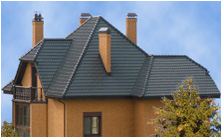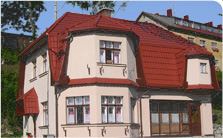Underlay film
Underlay film
Constantly growing demands on the quality of constructed roofs cause a more professional approach to the construction of roof structure in general. In the minds of the consumer durable reinforced the idea that the roof design to perform competently, we complete it with all the necessary ingredients. Extremely important component is the underlay film. It therefore seems appropriate to once again focus on the features and installation of the material.
Of course, when it comes to protecting roofing from heat loss and damage, considerable attention is paid to a vapor barrier, waterproofing and roof ventilation. Damage to the exterior walls due to condensation in the cross section are rare. Determined the approximate calculation of the amount of condensate that occurs during the winter, and the estimated amount of the drying of moisture in summer are comparable. Thus, the estimates used in the construction category, precluding the formation of large amounts of moisture. If a condition is not satisfied, you should also introduce the inside vapor barrier.
Much more common injuries in the construction of insulated roofs. In winter, through the construction of the roof is heavily counter diffusion: water vapor from the air of the internal environment of the building to the environment and other gases that make up air from the outside inwards. Diffusion of vapor through the structure should not be confused with the air permeability *.
Vapor diffusion - molecular phenomenon in which the only movement of water molecules in the direction of the lowest partial pressure. The degree of dampening construction for the winter depends on the availability of certain components (vapor barrier, waterproofing, etc.). In the design of the roof sections should be arranged with decreasing paroizoliruyuschey and an increase in heat-insulating ability in the direction from the inside out (DBN B.2.6-14-95 "Construction of buildings and structures. Coverings of buildings and structures").
Thus, to ensure the proper moisture condition of the roof structure must be in its composition to provide vapor barrier (usually located on the inner surface of the enclosure heated buildings), and waterproofing.
Most Ukrainian builders, roofers and architects familiar with the widely known and time-tested underlay films Gidrobarer, vapor barrier and Antikondensat.
The Ukrainian market their supplies Euroizol company is official dealer of the largest manufacturer of materials of polyethylene and polypropylene companies JSC "Utah" (Czech Republic).
From the beginning of its establishment until today, the company Utah passed a long way. And now, having at its disposal 11 plants, which involved 1900 people, the company "Utah" is among the largest manufacturers in its field, winning well-deserved trust from numerous customers.
In 1997, the production company was able to appreciate and the domestic consumer, as it was then that the company "Utah" and came to our Ukrainian market, finding a reliable partner in the company Euroizol. Products are offered in Ukraine under the registered company Euroizol "trademarks: Gidrobarer, vapor barrier and Antikondensat.
What is a production of the enterprise, how to choose the sub-roof foils, depending on whether a particular type of roof you need to know about installation - these matters subject of this article.
Gidrobarer D (11 OCT transparent or 96SI Silver) - vapor permeable (diffusion) underlay film, which is used in the construction of pitched roofs, where as the main roofing material used any material other than metal: tiles (concrete, cement and sand, ceramic, polymer, bitumen), Slate, Euro-slate, etc.
For roofing pie using metal, metalloshifera, corrugated galvanized sheet, or simply developed a special kind of film with the absorptive capacity - Antikondensat N140 (130), which serves to protect against moisture penetration from the outside into the internal structure of the building, as well as soot and dust into the ventilated systems sloping roofs. At the same time it prevents the swelling of the condensing water vapor in the insulation applied through the use of Desiccant-based nonwoven viscose.
Antikondensata advantage is its exceptional durability and high resistance to UV radiation (up to 12 months).. This means that the roof after the installation of such a film may be left without coverage for a longer time than other films of the underlay. On the other hand, due to its high strength it can withstand a large temporary loads, such as a layer of snow or the weight of the installer.
Vapor barrier H (11 OCT transparent, 96SI silver aluminum or 170) - vapor-proof protective under-roof foil that is used to form a protective layer on the inside insulation underlay Space pitched and flat roofs. It is known that humidity contributes to heat the material. Therefore, the application of this film should be even with a possible 3-percent moisture insulation.
The most important characteristics of the underlay films:
1. Water vapor permeability
G/m2/24 measured in hours. Characterizes the "speed" leveling the pressure of water vapor between the two environments separated by a test on the vapor-permeable film. Water vapor permeability - a very important indicator for the underlay material, which depends on its thickness d (M), ambient temperature and material structure. Than the layer thickness, so it is less permeable. Thus, comparing the technical characteristics of different films, we must first of all, compare the equivalent diffusion resistance of m.
2. Equivalent diffusion resistance m
m - dimensionless; m = water vapor permeability of the material / air vapor permeability, the values of the thickness of the material d and vapor permeability coefficient m is sufficient to characterize the vapor permeability of the material layer of certain thickness. To objectively judge the paropropusknyh characteristics of the films, you need to compare their size m. For Gidrobarera, the lower the value of m, the better the material passes pairs. For a vapor barrier, on the contrary (see table).
3. The equivalent diffusion thickness, CA
The equivalent diffusion thickness is measured in meters, and characterizes the thickness of the layer of air, which has an equal water vapor permeability of the material with a layer of thickness d and vapor permeability coefficient m. Determined by the formula: Cd = dxm
4. Strength
This is the second most important (after the equivalent diffusion resistance) index when choosing underlay film. It is estimated that the minimum allowable (both longitudinal and transverse) strength for the underlay of the film should be - 150N / 5 cm
What you should know about installing the underlay film?
Rolls Gidrobarera rolled along the roof with overlapping 10 cm Upper roll overlaps the bottom. Laying the film starts from the bottom of the roof and ends at the ridge (Fig. 1). Nailed to the rafters film clips or stainless steel nails. The gap between the film and the insulation should be 2-4 cm then the film is nailed kontrreyka and lathing. Ventilation gap between the film and the crate should be 2 see if you can not apply kontrreyki, you need to mount a film with a slack, as shown in Figure 2. One should not confuse the direction of the film laying Gidrobarer.
Film should be laid over a bright side marking tape to roofing. Gidrobarer can not be laid directly on the formwork or other flooring, to prevent its contact with insulation. The distance between the carrier film lags should not exceed 1.2 m.
Vapor barrier is fixed both horizontally and vertically on the inside of the insulation. Laying the film starts from the bottom of the roof and ends at the ridge. Nailed to the rafters film clips or stainless steel nails. Stacking is no gap (close to a heater).
All holes encountered in fixing the film, it is recommended to close the tape, Al-1. The film may be stacked on either side, but the flag should be connected tightly (with tape). Mount, as the wooden bearing elements, and to other materials can also occur with tape K-2.
Film Antikondensat be laid directly on the formwork or other flooring, to prevent its contact with insulation. The minimum clearance under the film should be 4 cm Antikondensat mounted absorbent layer inside the premises. The film is fixed directly on the plane trusses, lag or other elements of the roof so that the distance between them was not more than 1,2 m. Fixing the film in the lower zone of the roof and in the ridge must comply with the conditions necessary for the organization of the current of air, and in the zone ridge should remain a gap of at least 10 cm for ventilation.
Unfortunately, not all objectively assess the need for compliance with the above requirements. Trying to cut costs, some builders find it possible to violate the guidelines for installation. However, they did not even suggest that a few years every thing that saved, will have to change. So is it time to abandon the false stereotypes and by acquiring goods, raise the quality and durability at the forefront?
Source: BudMajster. Pokrіvelnі materіali. 2003. № 3. C. 16-17





